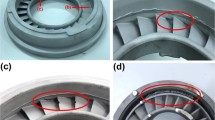Abstract
Dimensional accuracy is one of the most important criteria in the investment casting of turbine blades for aero engine applications. Although investment casting is an ideal route for producing net-shaped components, it necessitates accurate determination of the casting die profile. To avoid extensive modifications on the die cavity shape, this study proposes a simple but efficient inverse design method that adjusts certain geometric parameters to establish the die profile. Parameterized modeling is achieved by identifying the geometric parameters that describe the mean camber line of the blade profile. Meanwhile, blade shrinkages at different positions are effectively remedied through the adjustment of the parameters using the inverse iteration algorithm proposed in this paper. The relative positions among the cross-sections can also be varied to rectify the twist deformation of the blade, thereby guaranteeing the dimensional accuracy of the turbine blades. The applicability of this method is validated using numerical simulation data and experimental results.
Similar content being viewed by others
References
Chang HC, Lin AC (2005) Automatic inspection of turbine blades using a 3-axis CMM together with a 2-axis dividing head. Int J Adv Manuf Technol 26(7):789–796
Wu HH, Li DC, Chen XJ, Sun B, Xu DY (2010) Rapid casting of turbine blades with abnormal film cooling holes using integral ceramic casting molds. Int J Adv Manuf Technol 50(1):13–19
Kuo CP, Ling CC, Chen SH, Chang CW (2006) The prediction of cutting force in milling Inconel-718. Int J Adv Manuf Technol 27(7):655–660
Zhang DH, Jiang RS, Li J (2010) Cavity optimization for investment casting die of turbine blade based on reverse engineering. Int J Adv Manuf Technol 48:839–846
Brookes N, Besant C (1988) Reduction in the development lead times of complex investment castings by the application of CIM technology. Int J Adv Manuf Technol 3:41–49
Kim K, Yang D, Jeong J (2006) Plaster casting process for prototyping of die casting based on rapid tooling. Int J Adv Manuf Technol 28(9):923–929
Liu QB, Leu MC, Richards VL, Schmitt SM (2004) Dimensional accuracy and surface roughness of rapid freeze prototyping ice patterns and investment casting metal parts. Int J Adv Manuf Technol 24:485–495
Sun YF, Lee KS, Nee AYC (2004) Design and FEM analysis of the milled groove insert method for cooling of plastic injection moulds. Int J Adv Manuf Technol 24(9):715–726
Huang YM, Lan HY (2006) Compensation of distortion in the bottom exposure of stereolithography process. Int J Adv Manuf Technol 27:1101–1112
Sabau A (2006) Alloy shrinkage factors for the investment casting process. Metall Mater Trans B 37:131–140
Ferreira JC, Mateus A (2003) A numerical and experimental study of fracture in rp stereolithography patterns and ceramic shells for investment casting. J Mater Process Tech 134(1):135–144
Bonilla W, Masood S, Iovenitti P (2001) An investigation of wax patterns for accuracy improvement in investment cast parts. Int J Adv Manuf Technol 18:348–356
Wang SW, Zhuang WM, Cao J, Lin JG (2010) An investigation of springback scatter in forming ultra-thin metal-sheet channel parts using crystal plasticity FE analysis. Int J Adv Manuf Technol 47:845–852
Modukuru SC, Ramakrishnan N, Sriramamurthy AM (1996) Determination of the die profile for the investment casting of aerofoil-shaped turbine blades using the finite-element method. J Mater Process Tech 58(2–3):223–226
Mohaghegh K, Sadeghi M, Abdullah A (2007) Reverse engineering of turbine blades based on design intent. Int J Adv Manuf Technol 32:1009–1020
Mohaghegh K, Sadeghi M, Abdullah A, Boutorabi R (2010) Improvement of reverse-engineered turbine blades using construction geometry. Int J Adv Manuf Technol 49:675–687
Olama I, Besant C, Ristic M (1988) A CAD/CAM system for die design and manufacture. Int J Adv Manuf Technol 3(2):21–29
Korakianitis T, Sadoi T (2005) Turbocharger-design effects on gasoline-engine performance. J Eng Gas Turb Powe 127(3):525–530
Yang L, Ong SK, Nee AYC (2011) A new history-independent modeling approach for feature-based design. Int J Adv Manuf Technol. doi:10.1007/s00170-011-3559-0
Kumar N, Besant C, Ristic M (1988) Process variables determining the dimensional and metallurgical properties of directionally solidified, cored turbine blades produced by investment casting of super-alloys. Int J Adv Manuf Technol 3:3–19
Woon Y, Lee K (2004) Development of a die design system for die casting. Int J Adv Manuf Technol 23:399–411
Korakianitis T, Pantazopoulos G (1993) Improved turbine-blade design techniques using 4th-order parametric-spline segments. Comput Aided Des 25(5):289–299
Hsu TH, Lai JY, Ueng WD (2006) On the development of airfoil section inspection and analysis technique. Int J Adv Manuf Technol 30:129–140
Krimpenis A, Benardos P, Vosniakos GC, Koukouvitaki A (2006) Simulation-based selection of optimum pressure die-casting process parameters using neural nets and genetic algorithms. Int J Adv Manuf Technol 27:509–517
Besl PJ, Mckay ND (1992) A method for registration of 3-D shapes. IEEE Trans Pattern Anal Mach Intell 14(2):239–256
Author information
Authors and Affiliations
Corresponding author
Rights and permissions
About this article
Cite this article
Dong, Y., Zhang, D., Bu, K. et al. Geometric parameter-based optimization of the die profile for the investment casting of aerofoil-shaped turbine blades. Int J Adv Manuf Technol 57, 1245–1258 (2011). https://doi.org/10.1007/s00170-011-3681-z
Received:
Accepted:
Published:
Issue Date:
DOI: https://doi.org/10.1007/s00170-011-3681-z




